Unified
Government Affairs Department Works to Establish NCSBN as the Go-To Organization for Regulatory Issues

Inside this Issue:
Setting the Standard for the Next Generation NCLEX®
Simplify with e-Notify®
A Cry for Leadership Training
2023, Vol. 1
Managing Editor and Writer
Michael Grossenbacher | mgrossenbacher@ncsbn.org
Contributing Editor and Writer
Dawn Kappel | dkappel@ncsbn.org
Designer
Kalona Owens | kowens@ncsbn.org
Founded March 15, 1978, as an independent not-for-profit organization, NCSBN was initially created to lessen the burdens of state governments and bring together nursing regulatory bodies (NRBs) to act and counsel together on matters of common interest. It has evolved into one of the leading voices of regulation across the world.

NCSBN’s membership is comprised of the NRBs in the 50 states, the District of Columbia, and four U.S. territories — American Samoa, Guam, Northern Mariana Islands and the Virgin Islands. There are five exam user members and 25 associate members that are either NRBs or empowered regulatory authorities from other countries or territories.
Mission: NCSBN empowers and supports nursing regulators in their mandate to protect the public.
The statements and opinions expressed are those of NCSBN and not the individual member state or territorial boards of nursing.

Copyright ©2023 National Council of State Boards of Nursing, Inc. (NCSBN) All rights reserved. This document may not be used, reproduced or disseminated to any third party without written permission from NCSBN.
Address inquiries in writing to NCSBN Permissions, 111 E. Wacker Drive, Suite 2900, Chicago, IL 60601-4277. 312.525.3600 | www.ncsbn.org | infocus@ncsbn.org
4 16 Unified


2023, Vol. 1 | 3
2023, Vol. 1 Practice Ready: Setting the Standard for the Next Generation NCLEX® (NGN) ....................... 4 Simplify with e-Notify 8 Pathways to Leadership: A Cry for Leadership Training ................................ 12 Unified 16 Government Affairs Department works to establish NCSBN as the go-to organization for regulatory issues. Speed Round 27 News & Notes ....................................................... 28 8
In This Issue
Practice Ready: Setting the Standard for the Next Generation NCLEX® (NGN)
NCSBN conducted standard-setting workshops for both the NCLEX-RN® and NCLEX-PN® exams in summer 2022. This article explains the significance of these workshops and their impact, directly or indirectly, on areas of interest to regulators such as NCLEX pass rates, program evaluation and workforce planning.
What is standard setting?
A vital component of all credentialing programs, standard setting is an evidencebased methodology for establishing the passing standard (sometimes called “cut score” or “passing score”) associated with an examination. For the NCLEX, the passing standard acts as the dividing line between examinees who have demonstrated the knowledge, skills and abilities required to provide safe and effective care and those who have not. At its core, the NCLEX standard setting answers the critical question of how well examinees must do in order to demonstrate practice readiness.
Is standard setting something new?
Standard-setting practices have been around for decades and over the years, research on valid methods and well-established procedures for undertaking the standard-setting panel have been developed. Frameworks have also been developed to help guide standardsetting procedures. Following the standards
and established procedures ensures that the resulting passing standard is valid and defensible.
Why did standard setting take place in summer 2022?
The most recent standard-setting workshops were necessary for two reasons:
1. It was the natural time to revisit the passing standard since the previous standards had been in place since 2019 for the NCLEX-RN and 2020 for the NCLEX-PN. Periodic reevaluation ensures alignment with any changes in the profession or levels of competency required. It is important that the passing standard for the exams keep pace with the demands of entry-level nursing and reflect the standards needed to provide safe and effective care.
2. NCSBN introduced various “next generation” changes to the NCLEX that will take effect in April 2023, including clinical judgment items and case studies. While items in the NCLEX item bank have
continued on page 6
4 | In Focus

2023, Vol. 1 | 5
always assessed aspects of clinical judgment, there had not been a systematic methodology for measuring clinical judgment specifically. Therefore, reevaluation of the NCLEX passing standards was necessary to reflect the new changes.
Who participates in a standard setting?
Each standard-setting panel was composed of a group of subject matter expert (SMEs) nurses who were nominated by the NCLEX® Examinations Committee and approved by the NCSBN Board of Directors. Panels were comprised of a diverse sample of individuals from each U.S. region, plus two Canadian representatives for the RN panel. Among the participation requirements were unencumbered, active nursing licenses and representation across culture/ethnicity, gender, geographic location, practice setting, nursing specialty and years of experience. For example, care was taken to ensure representation from nursing educators, nurses in clinical practice and entry-level nurses with less than one year of practice.
How does NCLEX standard setting work?
The main method NCSBN utilizes for standard setting is called the modified Angoff, named for a 20th century psychometrician who pioneered the method. The modified Angoff is one of the most researched and frequently used methods in practice today. With decades of research behind the approach, it provides a sound methodology for setting a defensible standard that differentiates between candidates who are minimally qualified and candidates who are not.
The modified Angoff approach occurs in two rounds. Following initial training and discussion about what a minimally competent candidate looks like in a particular content area, all panelists will review a group of items from that content area and individually assign ratings based on how they believe minimally competent candidates would
perform on these items. Feedback is then provided based on aggregating the ratings of all panelists, and this feedback is followed by group discussion. Panelists then assign their second-round ratings, which again are aggregated into a single measure reflecting the work of the entire panel.
Notably, the modified Angoff method was designed for what are known as dichotomous items, i.e., items where a response is either right or wrong. However, one of the changes associated with the Next Generation NCLEX is the adoption of partial credit (or polytomous) scoring for many of the items. As such, NCSBN integrated two additional standard-setting methodologies designed for polytomous items: the option Angoff, which was used in the first round, and the extended Angoff, which was used in the second round.
Finally, the NCLEX standard setting also incorporated the Beuk compromise procedure Unlike the aforementioned approaches, which involved rating items based on expectations around how minimally competent candidates would perform, this final approach asked the panelists to think about the entry-level nurse population and make general judgments about their overall performance and competency. Among other things, the inclusion of this alternative approach served to broaden the range of possible passing standards for decision making.
What were the results of the standard setting?
Having received and reviewed the results and recommendations of the standard-setting panels, along with other pertinent information, the NCSBN Board of Directors voted on Dec. 6, 2022, to uphold the prior passing standards of 0.00 for the NCLEXRN exam and -0.18 for the NCLEX-PN exam. Each of these passing standards will remain in effect with the launch of the Next Generation NCLEX on April 1, 2023.
6 | In Focus
continued from page 4
Great care was taken in the standard-setting process and the development of a passing standard that demarcates the minimally competent candidate who can practice safely and effectively. All professional standards and procedures were followed to ensure the validity and defensibility of the passing standard.
More information on the passing standard can be found here. Watch our video about the Next Generation NCLEX launching in April 2023, and experience the enhanced exam with our sample pack.

Apply Today
Center for Regulatory Excellence (CRE)
The CRE provides financial support for scholarly research projects and offers programs that cultivate regulatory professionals.
• The CRE Grant Program awards up to $300,000 for nursing regulation and policy research projects.
• Regulatory Scholars Program:
• CRE Grant Program for Doctoral Students (awards up to $30,000)
• Scholar in Residence
• Unpaid Graduate Internship
2023, Vol. 1 | 7
Funding for Your Work

Simplify with e-Notify

Three Boards of Nursing Share their Experience Using the Free Nursys® Service
“In our day jobs, we are all asked to do more with less,” states Adrian Guerrero, CPM, director of operations for the Kansas State Board of Nursing. “Often it feels like we are climbing an ever-growing mountain of things to do.”
If this sentiment feels all too familiar, it’s time to ask if your state is getting the most out of Nursys e-Notify® from NCSBN. The free service not only reduces work for board of nursing (BON) staff but provides other benefits as well. Lori Scheidt, MBA-HCM, executive director of the Missouri State Board of Nursing, cites the following benefits of e-Notify:
• Better public protection
• Increased customer satisfaction
• Decreased operational costs
• Decreased staff time
• Decreased fraud
• Collection of workforce data
Mark Majek, MA, PHR, SHRM-CP, director of operations for the Texas Board of Nursing, echoes these points as well, noting increases in on-time licensure renewals, which is important to workforce continuity across the state. He also gets specific when asked how e-Notify promotes patient safety.


“Our mission is to protect the public,” offers Majek. “One aspect of this is that appropriate people are notified when there is action on a nursing license. For example, state law requires that we notify employers in these situations. We have always done this through our newsletters, but now e-Notify does it even faster than we can— immediately, really.”
Guerrero touts the value of the service where fraud is concerned. “In this day and age where identity theft is on the rise, subscribing to Nursys e-Notify empowers the nurse. In the unlikely event an imposter situation occurs, the nurse would be notified. This helps not only the nurse but also the BON, who would also become aware of the imposter activity.”
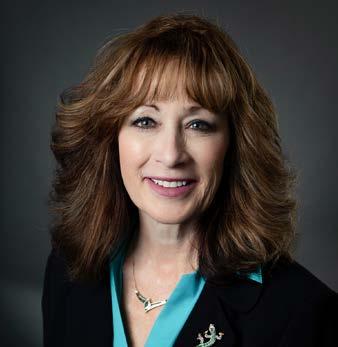
Scheidt contrasts the support e-Notify provides in renewals with the manual, time-consuming processes BON staff undertook previously. “I can remember the BON receiving large lists of nurses during license renewal periods and requiring team members to manually verify large lists of employers. We eventually evolved into conducting electronic match queries, but these were also problematic because records that did not match required manual intervention to resolve.”
So what exactly is e-Notify, and how are these three NCSBN member boards deriving so many benefits from it? The answer to these questions begins with an understanding of the Nursys® database. Thanks to the efforts of member BONs and NCSBN technical staff, the Nursys database
continued on page 10
2023, Vol. 1 | 9
Guerrero
Majek
Scheidt
continued from page 9
houses current and accurate licensure data from all U.S. BONs. Relevant data from Nursys are then pushed to e-Notify subscribers, either individual nurses or institutional accounts, when important changes like expirations or disciplinary actions occur.
Because Nursys aggregates data across jurisdictions, the information it provides exceeds what state licensure websites can offer alone. For example, a Nevada-based employer subscribing to e-Notify will not only be alerted when there is action against an employee’s nursing license in Nevada, but even if action is taken in another state such as Tennessee or Wyoming. This additional layer of public protection, requiring only that employers subscribe to e-Notify, is one that likely would not happen otherwise. Use of the service by employers is voluntary, but Scheidt describes some strategies Missouri has used to encourage signups.
“On the employer front, we partnered with NCSBN to do a joint NCSBN/BON virtual presentation to hospitals through our state hospital association,” Scheidt recalls. “We also make sure we promote the use of e-Notify in all BON outreach across all functional areas; discipline, nursing education, practice and investigations. That said, we still have work to do to get the message out to all employers. I recall when I was finally able to meet with the credentialing department of a major hospital system. They were in awe of the system and quickly realized how they could significantly reduce workload by integrating their system with Nursys using the application programming interface (API). Their only regret is they didn’t know about it sooner.”
Per Guerrero, the Kansas BON has also worked hard to encourage employer signups. “We market the service every opportunity we get. If we go out and speak to students or nursing program administrators, or employers, Nursys.com and Nursys e-Notify are regular topics we highlight
during our presentations. We also continually market the service via our board of nursing newsletter, website and social media offerings.” Guerrero added that even the board’s open records requests and staff email footers encourage e-Notify enrollment. Majek cited the Texas board’s newsletter as well, also adding the BON ListServ communications as a means of promoting e-Notify.
Individual Enrollment (data as of Oct. 13, 2022)
Where individual participation is concerned, Missouri has absolutely lived up to its state’s nickname, requiring that applicants “show me” their e-Notify enrollment as a condition of licensure renewal. The result is that 100% of Missouri nurses are using the service. At this time, Missouri is the only NCSBN member board that requires individual enrollment. However, five other jurisdictions currently have more than 70% of individual nurses subscribing to the e-Notify service.
While Kansas and Texas are not among these five, there is some friendly competition between the two states to move up on the leaderboard. Success here requires an understanding of the main barriers to enrollment. This is something Kansas has thought about quite a bit.
“The main reason is that most nurses only interact with the BON when their license renewals are due,” explains Guerrero. “They may only see us as ‘the board’ and not more fully as a service provider of personal licensure and regulatory information. I think we can change that perception by doing a
10 | In Focus
Percent Missouri 100 Delaware 82 New Mexico 79 Washington 73 Nevada 71 Louisiana-RN 70
Jurisdiction
better job marketing our services as more than just license renewals and finding creative ways to bring this importance to front of mind.”
Guerrero explains that BONs can do this by sharing the many benefits of Nursys e-Notify at every opportunity and embedding some of these technologies within their online licensure systems. “One such example is integration of the e-Notify API into our renewal and application systems to create a secure system-to-system communication process,” he says. “This step will require involvement of our information technology staff, but it’s one that should generate quick adoption of e-Notify by our licensees.”
Majek suggests a complementary viewpoint on behalf of the Texas board. “In Texas, we actually see e-Notify as an extension of the BON,” The implication here is not only an internal one, i.e., that e-Notify operates that way by handling some of what board staff might otherwise do. The idea of e-Notify as an extension of the board also applies to how external stakeholders have come to view e-Notify, recognizing it as a self-service area of the BON, open 24/7/365.
As the examples of Kansas, Missouri and Texas all make clear, e-Notify offers a myriad of benefits across the entire nursing ecosystem: boards, individual nurses, employers and the public. However, taking advantage of these benefits depends not only on adoption of the free service by institutions and individuals but also, in some cases, on the integration by BONs of e-Notify into their regular operations and processes. As always, NCSBN is available to assist BONs in their efforts to increase awareness and usage of e-Notify in their jurisdictions. Please contact Jason A. Schwartz, director of outreach, if we can help in this area.

A Cry for Leadership Training


Education consultants at the Texas Board of Nursing provide a mandatory orientation workshop for new nursing education program directors three times each year. In 2019 a new section, titled “The Successful Program Director,” was added. Lead Nursing Consultant for Education Janice Hooper, PhD, RN, FRE, CNE, FAAN, ANEF, who developed and presents this section, describes how it came to fruition.
“Following one of the in-person workshops, a new director approached me to say, ‘That was good, but I thought you were going to tell us how to be a director.’ I realized that the new directors were seeking guidance for their recent leadership role,” says Hooper. “My colleagues agreed to add a section on leadership skills to the orientation. So, that is what started this. We can’t really be a mentor to them; that’s not our role. But we can certainly give them some key points to guide them and tell them, under our rules, what their rights are and their responsibilities. And that’s a part of their leadership.”

Pathways to Leadership | Members of NCSBN’s Leadership Succession Committee Share their Journey
Hooper
Hooper explains that many directors are thrown into leadership roles. “Maybe they have never done this before. Maybe they don’t even have a job description, to know what they are expected to do. I know, even in my life, I have assumed a lot of leadership roles. And I was never looking for those things, but you get pulled up. Reflections on my past experiences reminded me that such a shift can create discomfort and insecurity. I can sense that a lot of new directors are afraid to make many demands because they are afraid they will not be able to keep that position, but they really should feel that they have a right to be the authority figure over their programs.”
Prior to the pandemic, directors traveled to Austin for a full day of presentations by staff from the Education, Licensing, and Enforcement Staff on board rules and regulations. The workshops have been shortened and offered in a virtual format. This has allowed a larger audience to attend with a number of repeat attendees seeking updates. “We have a turnover of 60 to 65 program directors, and that’s a lot of people,” says Hooper. Some of them also bring other people from their organization. In our last meeting, we had 98 in attendance, half to two-thirds are directors themselves, and some of them are repeaters. They’re coming back because they want more.”
Hooper says evaluations and comments from the attendees following the workshop have been very positive. “Excellent information that is desperately needed to efficiently and effectively lead a nursing program,” said an
attendee of one session on an evaluation.
“Thank you for providing such a thorough presentation of a director’s role,” said another. Hooper’s outline for her section of the workshop includes:
1. Responsibilities of Program Directors listed in Board Education Guideline and Board Education Rules
Reviewing the expectations of the program director from regulation not only advises the director about board requirements but authorizes him/her to carry out the responsibilities. Often the administration of the governing entity does not appreciate the authorization awarded directors. Board staff invite and encourage administrators to attend the workshops for their introduction to board staff and to understand board rules.
2. Character: The Basis for Successful Leadership
The word leadership in most references begins with descriptors of character that also reflect ethics and values essential in respected leaders. These descriptors also cause an inner evaluation of self, often accompanied by an intent to possess those qualities. Character is not a hidden quality but an obvious quality since it is reflected in behavior.
3. Tips for Effective Leadership

New directors are eagerly seeking tips for success since their main goal is to be successful.
continued on page 14
2023, Vol. 1 | 13
4. The Dance between Leaders and Their Followers
The Leadership Dance, described in John C. Maxwell’s Leadershift, presents essential changes every leader must embrace, and emphasizes the relationship between leaders and followers.
5. Emotional Intelligence in Leadership

Emotional intelligence often refers to the maturation of young people to be able to handle life and work challenges. Using Daniel Goleman’s Social Intelligence: The New Science of Human Relationships, points are made that high emotional intelligence is linked to leadership.
6. The Leader in 2022 and Beyond
Steve Adcock, a software developer who has gained fame and notoriety for promoting early retirement, has outlined five powerful ways to become a better leader in today’s world.
“Every time I give this presentation, I try to find a new book or article I can add,” says Hooper. “I want to make sure it’s not the same thing because many attendees come back. But I’m very selective in what I choose. There is no lack of available information about leadership in books, articles, and online suggestions, so the challenge is selecting the best concepts that could be presented in a short period of time.” In addition to the links listed previously, other sources of inspiration were Emotional Intelligence for the Modern Leader by Christopher D. Connors and the works of Stephen R. Covey
Hooper says that her presentation is a work in progress, with continual changes based on new information and ideas from the directors themselves. “The education team over whom I serve as supervisor sits in the audience with new directors, so it is imperative that I speak from the heart, humbly and with honesty. I think it has probably helped me to be a better leader. I am challenged to better portray the characteristics I recommend. I believe everyone will be a leader at some point -- in their work, organizational settings, social settings or home environment – and readiness is paramount for success.”
Take the Lead and Participate in NCSBN
The members of NCSBN’s Leadership Succession Committee endeavor to provide future, emerging and current leaders with an insider’s look into the value of serving in a NCSBN leadership role. NCSBN members can pursue a variety of leadership paths to support their professional development. Getting involved with NCSBN benefits you both personally and professionally. Find out how to apply for a leadership position (member login required).

continued from page 13 14 | In Focus

SHINE THROUGH SHAPING A BRILLIANT FUTURE 45 2023 MIDYEAR MEETING MARCH 28-30, 2023 | SEATTLE REGISTER TODAY
Unified
Government Affairs Department Works to Establish NCSBN as the Go-To Organization for Regulatory Issues
The political environment of the last several years has been volatile and uncertain. Tied to many of the challenges brought on by this ever-changing and somewhat unstable landscape are the issues affecting health care; most specifically nursing and nursing regulation.
NCSBN has a long history of efforts to ensure that state and federal policymakers are aware of the pressing concerns of nursing, and has worked diligently to advance regulatory issues in the mission of public protection.

NCSBN has:
• Advocated for allowing advanced practice registered nurses (APRNs) to practice to the full extent of their education and experience
• Championed the Nurse Licensure Compact (NLC) and the APRN Compact
• Provided comprehensive national nursing workforce data
• Supported telehealth initiatives aimed at offering greater access to care
on page 18 16 | In Focus
continued

2023, Vol. 1 | 17
In October 2022, NCSBN reconfigured its key policy positions into a new department aptly titled Government Affairs. The person tasked with making the policy group an even more successful and cohesive unit is Jim Cleghorn, MA, director, Member Engagement and Government Affairs. Cleghorn is a relatively new NCSBN employee but no stranger to the organization, or to nursing regulation. He previously served for more than 10 years as the executive director of the Georgia Board of Nursing and as Area III Director, Presidentelect and President on the NCSBN Board of Directors.
Cleghorn
When asked how this reorganization benefits NCSBN and its members Cleghorn commented, “Just being able to work across what have traditionally been boundaries between the state and the federal policy positions -- to form a unified, strong team where we can lean on each

other for connections, for information, for ideas, innovation -- is invaluable. Working in concert will help us advance some of the initiatives that the organization has set before us right now.”

This newly structured team also has the advantage of being able to more readily call upon the Member Engagement department which Cleghorn also oversees. “We also need to be able to understand what the membership’s policy related concerns are. We need to work with them to advance the NLC, the APRN Consensus Model and the APRN Compact.”
There are some challenges that the new department needs to meet head on: dealing with both the changing leadership at the board of nursing jurisdictional level, disruption in communications channels during COVID-19 between the membership and also figuring out how to leverage what was learned during the pandemic about the mobility of nurses.
continued from page 16
Cleghorn notes that the number of executive officers (EOs) who are new to their role in the last year has increased dramatically. These new individuals often need to become familiar with leading in a regulatory environment and develop a relationship with NCSBN and their fellow EOs before they can even begin to dialogue about policy issues.
“The last two years have really tested our ability to communicate, our ability to be together and to network. We need to reestablish older relationships, and then connect with the new ones,” he adds.

Cleghorn does see one bright spot coming out of the pandemic, “I think we do have the opportunity to take advantage of the position that we’re in at this point and use the lessons that we learned over the last two years to underscore the need for the mobility of nurses, whether it be at the national level or even at the international level.”
Cleghorn notes that everything NCSBN does circles back to the protection of the public. As one example, he mentions the executive orders many states enacted in 2020, allowing already vetted nurses to travel into states to meet the demand for care due to the COVID-19 pandemic. “Some states are still using executive orders to meet demand, but what happens if someone’s practicing in your state under that executive order and something occurs that requires disciplinary action?”
He describes that in such a circumstance, the state doesn’t have the statutory authority to proceed, and there may not be anything they can do because the state where the nurse is actually licensed cannot take action since they don’t have jurisdiction. The conduct didn’t occur in the state of licensure. “That’s when it really hits home,” Cleghorn adds.
continued on page 20
2023, Vol. 1 | 19
The last two years have really tested our ability to communicate, our ability to be together and to network. We need to reestablish older relationships, and then connect with the new ones.
— Jim Cleghorn
On the other side of the coin, some emergency provisions were beneficial for both nurses and patients. Cleghorn expresses concern that states will want to reset to pre-pandemic levels. He asserts, “You would think that the jurisdictions would be interested in doing a postimplementation assessment to measure the impact of the provisions that were made to deal with the crisis. As one example, we know that the relaxation of certain telehealth regulations allowed patients with chronic medical conditions to still be monitored and assessed when they couldn’t do so in-person. Legislators need to ask themselves: Is this is something that’s going to help our citizens? Can this provide greater access to care? Does this eliminate an unnecessary barrier? Those are some of the questions that our department is going to try to get them to ask – and answer.”
With more than 13 years in his position, James Puente, MS, MJ, CAE, director, Nurse Licensure Compact, has steadfastly supported and promoted the NLC and the Interstate Commission of Nurse Licensure Compact Administrators (ICNLCA) throughout his tenure. He is joined by new staffer, Lisa Sands, associate, NLC.
When the pandemic was declared in March 2020 there were 34 member jurisdictions in the NLC that had the regulations in place allowing mobility for registered nurses (RNs) and licensed practical/vocational nurses (LPN/VNs) to provide care and respond appropriately to areas of greatest need. How to use the success of what happened to convince

other states that the NLC will not only benefit the nurses in their jurisdiction but also its citizens, is the next task on the horizon.
Echoing Cleghorn’s thoughts on one of the greatest challenges facing health care being the ongoing and ever worsening nursing shortage, Puente believes that the pandemic may have informed legislators in noncompact states that all possible remedies need to be implemented to help with the nursing shortage, and mobility of nurses is just one aspect of it.
While he acknowledges that the NLC alone cannot solve this multifaceted crisis, it can offer the removal of certain roadblocks that may hinder access to care. “We must make our health care system work with a finite number of nurses,” Puente comments. “And we need to remove impediments for nurses so they can practice in whatever location they’re needed. And that’s what the compact does.”
Even though Trust for America’s Health has repeatedly recommended compact membership as the number one element in state emergency public health disaster preparedness, noncompact states learned during the pandemic that they were not able to utilize all of the tools that were available to them, most notably, the NLC.
In the aftermath of COVID-19, Puente feels that states are starting to recognize that the emergency orders that they did put in place were confusing and burdensome. He elaborates, “The emergency declarations were problematic on a number of different fronts depending on the state. In some cases, retirees were called into work when they may have been out of practice for a number of years and whose current clinical
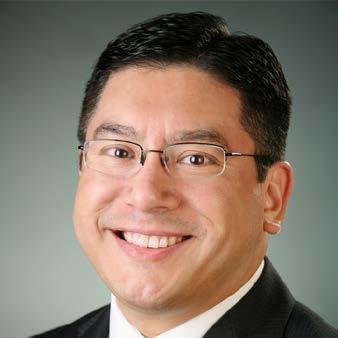
20 | In Focus
continued from page 19
Puente Sands
skills were unknown. Additionally, some states allowed nursing students to work before passing the NCLEX® exam, even when it is known in every state a certain percentage of nursing students don’t pass NCLEX, which is one of the essential steps in licensure of a safe and competent workforce.”

For health care facilities, emergency orders proved to be a source of frustration because the orders had an expiration date to them. That made staffing very difficult because the facilities didn’t know if there would be an extension beyond the expiration date. Facilities found it very challenging “to turn on a dime” and continue staffing with hundreds of thousands of temporary agency nurses at a moment’s notice.
From a public safety and regulatory perspective, a number of these emergency measures allowed nurses to travel to another state to practice if they had a license in good standing in the state where they lived. However, as Puente notes, this too was problematic. “It did not give the state the right to take adverse action against the nurse if the nurse violated that state’s laws. The state did
not have jurisdictional authority because they did not issue the nurse’s license. The advantage of the NLC is that it gives both the home state and remote state the authority to take action if there’s a violation of state laws.”
When asked whether he thinks that 2023 will add more member jurisdictions to the NLC, Puente remarks, “I am optimistic that we’re getting back to a sense of normalcy in our environment. We’re not in fight or flight mode at this point, where we feel that emergency declarations are necessary. So, legislators can calmly think about what makes the most sense to help their state going into the future. When it comes to RNs and LPN/VNs, I think with nearly 40 states in the NLC, it is the gold standard for
continued on page 22
2023, Vol. 1 | 21
we need to remove impediments for nurses so they can practice in whatever location they’re needed.
— Jim Puente
dealing with public health crises and emergencies.”
Nicole Livanos, JD, MPP, who was recently promoted to the position of director, State Affairs, has been at NCSBN for seven years. Her previous responsibilities as associate director centered on promoting the APRN Compact and NursingAmerica, the APRN Consensus Model advocacy campaign. Now she will be managing the entire scope of state issues including NLC legislative efforts along with MollyMaeve Lusk, associate in State Affairs. “I am excited about the landscape ahead of us on the NLC stage,” Livanos says.
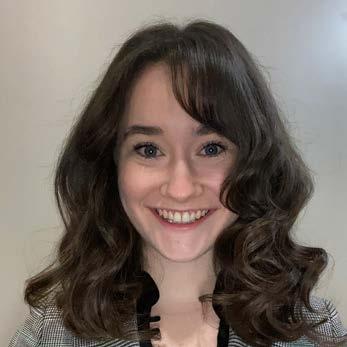
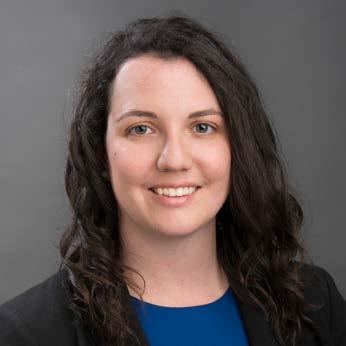
“Of course, with the majority of the remaining states being strong union states, we have both challenges and opportunities to see how we can message the NLC to union nurses, to lawmakers, as a benefit for union nursing and all of nursing. We want them to look at the NLC as a tool
for modernizing the nursing workforce and it, therefore, being an asset to union nurses to hold a multistate license.”
During the height of the pandemic, the regulatory landscape was far more challenging for APRNs than it was for RNs and LPNs holding multistate licenses, as the APRNs had to navigate a patchwork of regulatory emergency, legislative or executive orders that often shifted because orders expired. Livanos explains, “Often infighting between governors and legislative branches as to who had the authority to issue what emergency order and what the scope of emergency powers entailed. It was a very confusing situation where APRNs had to keep up with what the various different requirements were in each state for them to cross that border and practice in that state. Many of the emergency measures put in place to provide additional access to health care ensnared APRNs in so much red tape it made their ability to be agile and mobile very difficult. This also affected the delivery of telehealth, which was

continued from page 21
Livanos
Lusk
I look forward to a time when we can say that we have achieved licensure mobility for APRNs and they will no longer be restricted by state boundaries.
— Nicole Livanos
essential during the pandemic when much of care was shifted from in-person to telehealth.”
Livanos shares that had the APRN Compact been operational, it might have been able to provide the ease of cross-border practice that characterizes the NLC. While there are now three states that have enacted the APRN Compact (Delaware, North Dakota and Utah), the compact still needs four more states to enact legislation before it can be implemented.
However, Livanos is hopeful that APRNs will be able to provide high levels of care to patients across the U.S. in the near future, saying, “I look forward to a time when we can say that we have achieved licensure mobility for APRNs and they will no longer be restricted by state boundaries.”
While similarly new to her role as director, Federal Affairs, Kaitlyn Ward, MIA, is an NCSBN employee with five years of service, previously as an associate in Government Affairs. Ward works out of the satellite NCSBN office in Washington, D.C. along with her colleague Tyler Becklund, coordinator, Federal Affairs.
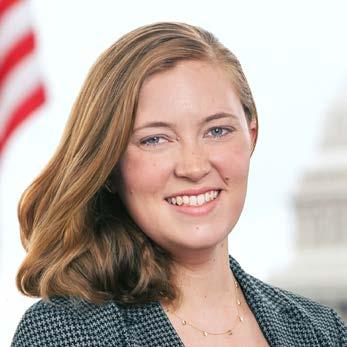
While some may wonder why an organization dedicated to

the advancement of state-based licensure established a D.C. office nine years ago, Ward sees it as completely congruent with NCSBN’s mission and strategic goals, saying “Every year bills are introduced at the federal level that can have direct impact on state-based licensure.”

Commenting on the newly configured department, Ward notes, “We’ve always worked well together and been extremely supportive of each other’s efforts but now there are even more opportunities for dialogue. We are now more diligent and intentional. I have gained a better understanding of what our members are concerned about and whether there are some niche issues we need to address.”
As part of her new role, Ward is visiting NCSBN Member Boards to learn more about how they function and how she can serve them. “If I hear that there’s an issue consistently coming up, that might be something I need to examine at the federal level. I am also strongly encouraging
2023, Vol. 1 | 23 continued on page 24
Ward
Becklund
If I hear that there’s an issue consistently coming up, that might be something I need to examine at the federal level.
— Kaitlynn Ward
those who are able to do so to connect with their members of Congress at the federal level,” she adds.

As a registered lobbyist, Ward engages with members of Congress on a regular basis because NCSBN supports funding for nursing research and other important issues like diversity in nursing. NCSBN is an important source for nursing data, including the national nursing workforce study the organization produces every two years, the newest version of which will be released in April 2023.
“Every time I have a meeting, I bring our workforce study and it is highly valued in those conversations. For some of the offices, that is really their first introduction to NCSBN -- having that meeting and presenting them with the workforce study, Ward

comments. “It gives them concrete data to say, ‘Look at the current state of the workforce, this is why they need that funding.’ I think the nursing workforce study is certainly going to be my most carried document to Capitol Hill this year!”
Reflecting on the department and its goals in the coming year, Cleghorn states, “NCSBN has a wealth of data, research and expertise that is invaluable to legislators and we want to establish NCSBN as the go-to organization for regulatory issues, not only at the state level but also at the federal level. I am confident that the staff we have assembled is more than equal to the task, I am energized and excited by the potential the future holds.”
24 | In Focus
NCSBN has a wealth of data, research and expertise that is invaluable to legislators and we want to establish NCSBN as the go-to organization for regulatory issues, not only at the state level but also at the federal level.
— Jim Cleghorn
Recognition. Celebration. Inspiration.
“A Recognition Beyond My Wildest Dreams”
Celebrate outstanding achievements in nursing regulation by submitting a nomination for the annual NCSBN Awards Program.

As we celebrate NCSBN’s 45th sapphire anniversary, we want to recognize ongoing projects and initiatives that make a difference and can inspire others. Visit the Awards Program webpage for guidance on preparing a compelling awards nomination.
Shine like a sapphire to shape the brilliant future of NCSBN



Submission Deadline: April 7, 2023

AWARDS
Foundations of Regulation
Dive into the world of regulation with courses designed for professionals looking to enhance their regulatory skills and knowledge. Perfect for new staff members or those interested in serving on boards and committees. Each self-paced course can be completed in one day and all offer continuing education (CE) credits.


Certificate Program

Take the next step in regulation with this competency-based program, offering courses to enhance leadership and governance skills. This online and blended curriculum is designed to cultivate and elevate leaders of state, national and international regulatory bodies. This two-year program provides specialized education on topics unique to health care regulation along three pathways: Governance & Leadership, Public Policy & Legislation, Research & Measurement
Advanced Leadership Institute
At the culmination of the ICRS certificate program, participants graduate at the Advanced Leadership Institute, an exclusive, invitation-only event that will take them to the next level in their journey as a leader in regulation. They will learn from prominent leaders and network with other regulatory professionals from around the world.



the courses at icrsncsbn.org
Explore
Speed Round
Get to know NCSBN staff:
Sarah Arias
Consolidated Services Specialist

What do you do at NCSBN?
I am a Consolidated Services Specialist I, and am currently in training to become an exams operations specialist. I work with nursing regulatory bodies to get accommodation requests granted for NCLEX candidates, review exam cases, and organize various communications we send out regarding the NCLEX.

What are the best and most challenging aspects of your job?
Working in Exam Operations is rarely boring! I’m always encountering interesting cases that happen during candidates’ testing, or ADA requests that I’ve never run into before. I’ve also had the opportunity to work with the NCSBN Meetings team for several NCSBN conferences, which helps to break up my normal routine because they are fast-paced and exciting. This is my first time working in the field of nursing, so there is a big learning curve, but I enjoy challenging myself and expanding my knowledge. I am proud knowing that I get to play a small part in helping the next generation of nurses enter the workforce.
If you weren’t working at NCSBN, what would your dream job be?
My dream job would pay for me to travel the world and experience new cultures. I worked as an English teacher for four years in South Korea and got to travel a lot around Asia in that time. I have had insatiable wanderlust ever since! I’m definitely looking forward to travel returning to normal as we learn how to adapt to a post-COVID world so I can start getting back out there and exploring new places!
I
2023, Vol. 1 | 27
News & Notes
Pfenning Completes Postgraduate Program Supported by NCSBN Member Scholarship

In August 2022, Stacey Pfenning, DNP, APRN, FNP, FAANP, executive director, North Dakota Board of Nursing, successfully completed the George Washington University post graduate Health Policy and Media Engagement program. Pfenning was supported by a scholarship awarded by NCSBN. The program provided experiences in health policy analysis and in delivering briefs to state and federal legislators. For one of Pfenning’s assignments, she provided a legislative briefing related to federal policy addressing the opioid epidemic to U.S. Sen. Kevin Cramer’s Health Advisory team in July 2022. The briefing packet provided important details of the CARA 3.0 Act of 2021, which is being considered at the 117th Congress and could potentially curb the opioid epidemic with implications at the national and state levels.
Porter-Edwards and UTHealth Recognized with AACN Award
Allison Porter-Edwards, DrPH, MS, RN, CNE, vicepresident, Texas Board of Nursing, has been recognized for her innovative work in disability nursing education.


Porter-Edwards serves as an assistant professor for the bachelor of science (BSN) Pacesetter program at the University of Texas Health Science Center at Houston (UTHealth) Cizik School of Nursing. Her submission showcasing the UTHealth Joan and Stanford Alexander Neurodevelopmental Disability-ASK Program was selected to receive the 2022 American Association of Colleges of Nursing (AACN) Innovations in Professional Nursing Award in the category of Academic Health Centers. The program recognizes the outstanding work of AACN member schools to re-envision traditional models for nursing education and lead programmatic change. Award recipients were acknowledged at AACN’s Academic Nursing Leadership Conference in October 2022 in Washington, D.C.
The ASK-Disability Fellowship, developed at UTHealth by Edwards, through the support of an endowment from Joan and Stanford Alexander, addresses a gap in education and training and ensures the next generation of nurses will transition to practice competently with requisite Attitudes, Skills and Knowledge, assuring delivery of quality care for people with disabilities.
Pictured left to right: AACN Board Chair Cynthia McCurren, UTHealth Cizik School of Nursing Dean Diane Santa Maria, Allison PorterEdwards and AACN CEO Deborah Trautman
28 | In Focus
Left to right: Jody Link, Director of Constituent Services for U.S. Sen. Kevin Cramer, and Stacey Pfenning
Virginia Board of Nursing RN Deputy Executive Director Leadership Team Receives Leadership Excellence Award
In September, the 2022 Virginia Nurses Foundation Gala recognized outstanding nurse leaders throughout the Commonwealth. The Virginia Board of Nursing RN Deputy Executive Director Leadership team received the Leadership Excellence Award in the State/Public Government Service category.
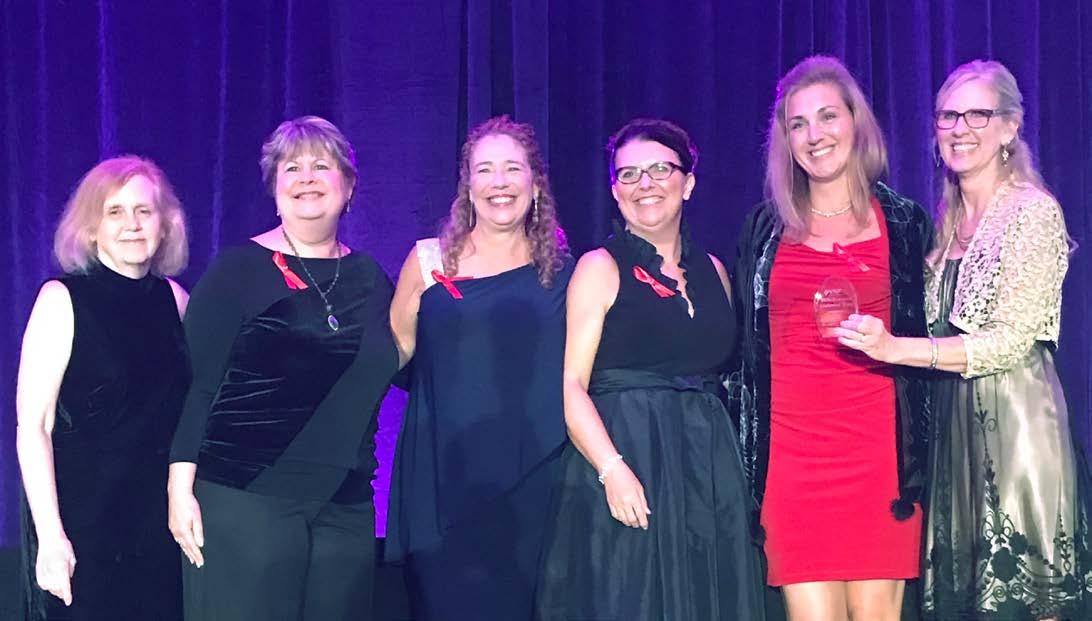
The RN Deputy Executive Director Leadership team includes:

• Christina Bargdill, MHS, RN, Deputy Executive Director for Nurse Aide, Medication Aide, and Massage Therapy
• Claire Morris, RN, LNHA, Deputy Executive Director for Nursing Discipline
• Jacquelyn Wilmoth, MSN, RN, Deputy Executive Director for Education
• Robin Hills, DNP, RN, WHNP, Deputy Executive Director for Advanced Practice
Virginia Board of Nursing Executive Director Jay Douglas, MSM, RN, CSAC, FRE, and Board President Brandon Jones, MSN, RN, CPXP, CEN, NEA-BC, nominated the deputies for their outstanding advocacy on behalf of the Commonwealth’s residents. The team’s work leading regulation through the COVID-19 pandemic was a specific focus of the nomination. They helped overcome enormous challenges and created a roadmap for providing the essential service of regulation in a remote environment. Thanks to their leadership and innovation, some of the processes pioneered by the deputy team have remained as new best practices in the regulatory space.
The full board recognized this award at their September business meeting. During this time, the RN Deputy Executive Director Leadership team publicly shared the award with their colleague, Stephanie Willinger, Deputy Executive Director for Nurse Licensing, CBC, and Call Center who they felt deserved the same recognition.
News & Notes highlights NCSBN member achievements and updates as well as individual leadership and staff accomplishments.
Have news to share? Send your
News
& Notes submissions via email
Pictured left to right: Kathy Baker, Trustee of the Virginia Nurses Foundation; Robin Hills; Christina Bargdill; Claire Morris; Jacqueline Wilmoth; and Phyllis Whitehead, President of the Virginia Nurses Foundation. Baker and Wilmoth presented the award.



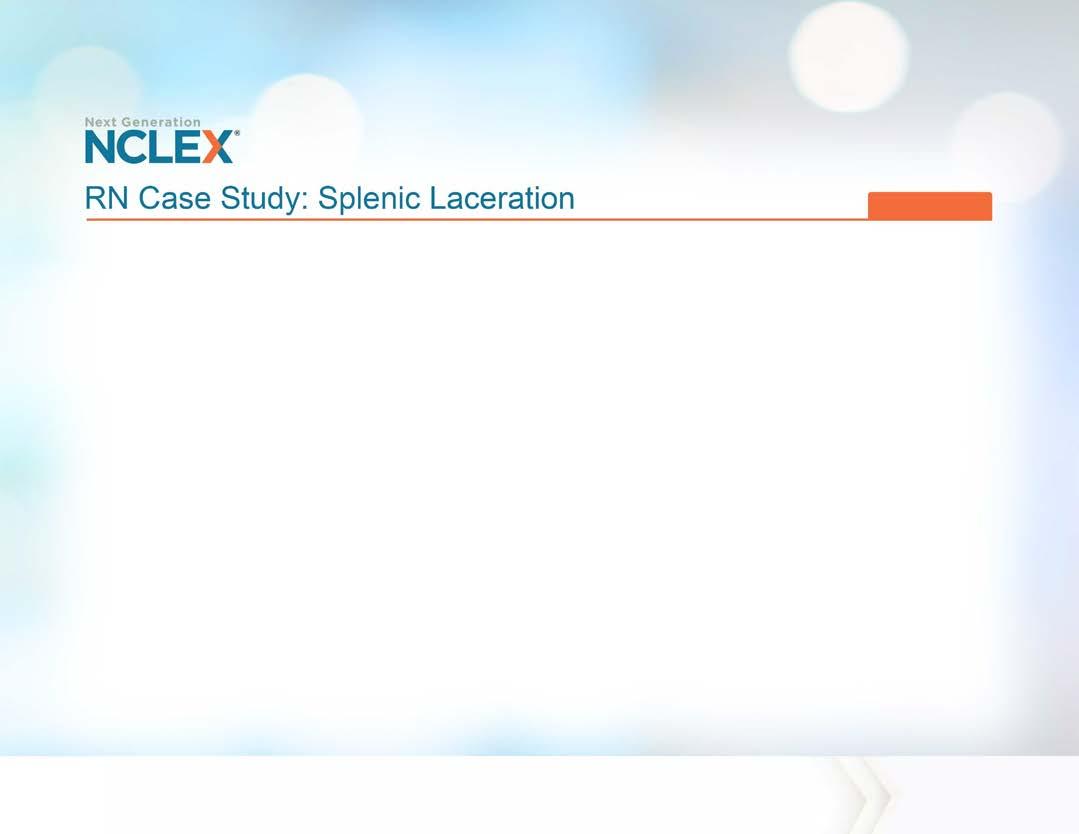
The Next Generation NCLEX (NGN) uses new types of questions to better measure clinical judgment. An Enhanced Exam for the Real World of Nursing Sample Questions Experience the NGN with our sample pack. Be Ready April 2023 nextgennurses.org Page 12/64 ©2021 NCSBN. All rights reserved. The nurse in the emergency department (ED) is caring for a 17-year-old male client. History and Physical Screen 1 of 6 Nurses’ Notes Vital Signs Laboratory Results Which of the following assessment findings require immediate follow-up? Select all that apply. Emergency Department Day 1 0900: Client appears pale and slightly diaphoretic. Large amount of bruising noted along the left torso and over the left upper quadrant (LUG) of the abdomen. Tenderness, guarding, and dullness to percussion noted on abdominal assessment. Slightly diminished breath sounds noted in the left lung fields on auscultation; client has a productive cough. Electrocardiogram (ECG) shows normal sinus rhythm. 1. lung sounds 2. shoulder pain 3. laboratory results 4. productive cough 5. abdominal assessment findings 6. pulse, respirations, and blood pressure 7. temperature and pulse oximetry reading FREE DOWNLOAD































































